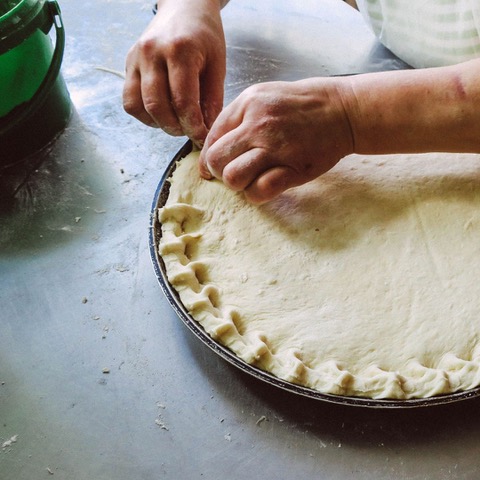Gluten is in a lot of things we eat, from bread and pasta, to cookies, pastries and even drinks like beer. It’s been a staple for thousands of years but, along with turning vegan, going gluten free has been one of the biggest health trends in the last decade and is almost as divisive. Some claim gluten is damaging their health. Others argue that we are at risk of nutritional deficiencies if we don’t eat it. So what’s the truth?
Like so many things these days, when there is a lot of information and opinion, the waters can become muddied and it’s not always easy to separate fact from fiction. Here is some of the science behind the gluten-free argument.
What is gluten is and where you’ll find it?
Gluten is a collective noun that refers to several different proteins found in grains like wheat, barley, rye and anything made from them.
The main proteins found in wheat are glutenin and gliadin, which are very elastic and give bread its stretchy quality. Some products naturally contain gluten, but gluten is also added in extra quantities to foods to add protein and texture, and to bind processed foods together.
You’ll find gluten in the following products (not an exhaustive list!)
Wheat flour
Durham wheat
Kamut
Semolina
Bread and breaded or battered foods
Pasta
Noodles
Soy sauce (Tamari soy sauce is gluten free)
Worcestershire Sauce
Many flavoured crisps
Barley squashes
Beer, lager, stout, ales
Cous cous
Bulgar wheat
Pies and pastries
Pizza
Cakes and biscuits
Dumplings and Yorkshire puddings
Breakfast cereals
Muesli
Many packet sauces (powders and liquid sachets)
OTHER INGREDIENTS
Malt extract
Malt vinegar
Barley malt flavouring
Brewer’s yeast
Edible starch
What’s the problem with eating gluten?
The gluten proteins are very hard for your body to break down and, when they don’t break down completely, they may cause inflammation in the digestive tract or promote intestinal permeability.
Coeliac Disease is the most well-known gluten-related problems. It’s an autoimmune disease triggered by gluten and it causes your body to attack the small intestine, resulting in damage to the lining of the intestine.
Symptoms range from digestive distress like diarrhoea, cramping and nausea (among others) to anaemia, neurological disorders and skin diseases like psoriasis and dermatitis.
Testing for coeliac disease is by intestinal biopsy, usually when the condition is very advanced. Email to ask me about this.
Wheat allergy is an abnormal immune response to one or more proteins found in wheat. Like other true allergies, the body makes a specific inflammatory response and symptoms can be mild or severe, including anaphylaxis, which can cause breathing difficulties and death. Allergies are usually detected using blood or finger-prick testing for IgE antibodies.
Non-coeliac gluten sensitivity is a ‘catch-all’ phrase that covers everything else. Advanced testing for gluten-related disorders (as mentioned above) can pick up if your body is making an unfavourable response to gluten. Or, quite simply, you might know that gluten causes you issues, which can mean anything from milder intestinal symptoms, headaches, joint pain and fatigue, as well as neurological symptoms. While not life threatening, these can still have a profound effect on your health and how you feel and should not be ignored.
Neurological symptoms, really? Yes. What we’ve come to understand about gluten is that it can cross the blood brain barrier in the same way the proteins slip through the normally tight junctions in the gut. If you’ve ever heard people talking about Leaky Brain, this is what they are referring to. Research has shown that gluten can cause central and peripheral nervous system and psychiatric disorders. Examples are migraines, anxiety or depression.
Gluten and Autoimmune Conditions
I see a lot of autoimmune clients in my nutrition clinic, mainly Hashimoto’s Thyroiditis and Ulcerative Colitis. Autoimmune conditions are inflammatory conditions which can be caused and exacerbated by intestinal permeability. One of the first things I ask those clients to do is eliminate gluten due to its negative effect on the integrity of the gut lining.
Why is this a problem NOW?
Bread and gluten-containing products have been around for thousands of years so why is this only a problem now?
The wheat we eat today is also markedly different from the historic versions thanks to industrial milling that brought us the almost entirely barren white flour and other highly processed foods that see today’s wheat stripped of many of its vital nutrients. Additionally, wheat is now grown very differently with fertilizers and pesticides to increase yields.
Dr William Davis, author of Wheat Belly, said: “This thing being sold to us called wheat – it ain’t wheat. It’s this stocky high-yield plan, a distant relative of the wheat our mothers used to make muffins – light years removed from the wheat of just 40 years ago.”
About ‘gluten free foods’
Don’t make the mistake of thinking gluten free foods are necessarily healthy. Any processed foods like breads, pastries, cakes and biscuits contain a long list of ingredients, some of which you may not have heard of before. The same is true of gluten free processed food.
Gluten free breads are a case in point. Because the gluten in regular flour gives bread it’s unique texture, it’s hard to recreate gluten free. This is why gluten free bread often contains corn starch, rice flour, tapioca starch and potato flour, which are more likely to spike your blood sugar levels, be lower in fibre and cost more than regular bread.
How to eat gluten free
If you suspect you have a problem with gluten, the answer is to eat no gluten at all. Don’t reduce it, don’t save it for treats. Because gluten intolerance provokes an immune response, there’s no halfway house. That means don’t eat any gluten-containing foods and try to minimise cross contamination with gluten products. The food industry has come a long way in the last few years, developing products and menus that contain no gluten, but you do need to be vigilant.
To start, you might find going zero gluten a struggle, but label checking and spotting cross contamination hazards will soon become second nature. Here are my biggest tips for following a zero-gluten diet.
1. Become an avid reader of food labels. Get to know which food types and which brands contain gluten and, therefore, need to be avoided.
2. Don’t afraid to say you need to avoid gluten. Real friends will try to accommodate you, and restaurants have an obligation to point out any potential allergens (and remember you are paying for the meal!)
3. Carry an emergency snack (nuts, seeds, a protein bar) in case there really is nothing else to eat.
Hidden gluten
Hidden gluten is found in many processed foods, including sausages and beefburgers, sauces and gravies. Some products, while they contain no gluten-based ingredients, may have been produced in a factory that handles gluten. This means cross contamination is possible (imagine gluten free food surrounded by puffs of normal flour). These are also ideally avoided. This is why oats can be bought as gluten free or regular. Oats themselves contain no gluten but they are often packaged in an environment where other cereals like barley and wheat are processed.
Eating out
Most restaurants now offer a gluten free (GF) menu and, if not, can often advise on GF options on a standard menu. If something is not listed as being ‘gluten free’, always ask the waiting staff. If they don’t know, ask them to check with the chef. Sauces are one of the things you always need to check. Check chips are not fried in the same oil used for breaded products.
It’s a good idea to call ahead to find out what the GF options are. You’ll soon build up a bank of favourite destinations you know can cater for you. Pizza Express, Ask, Prezzo and Zizzi now offer a gluten free pizza base and pasta. Coeliac UK provides a pretty comprehensive listing.
Cross contamination
This can happen very easily in any kitchen – including your own. Grills, pans, chopping boards and utensils may still have traces of gluten on them so wash them diligently. Take care if using normal flour as residues can remain in the air for up to 24 hours and settle on counters. Crumbs are another hazard – you’ll want a separate butter or spread you can designate GF. You’ll also want a new toaster or use toast bags to prevent the transfer of crumbs.
If you feel you may have developed an intolerance to gluten and would like to discuss this further, click here to book a free call


